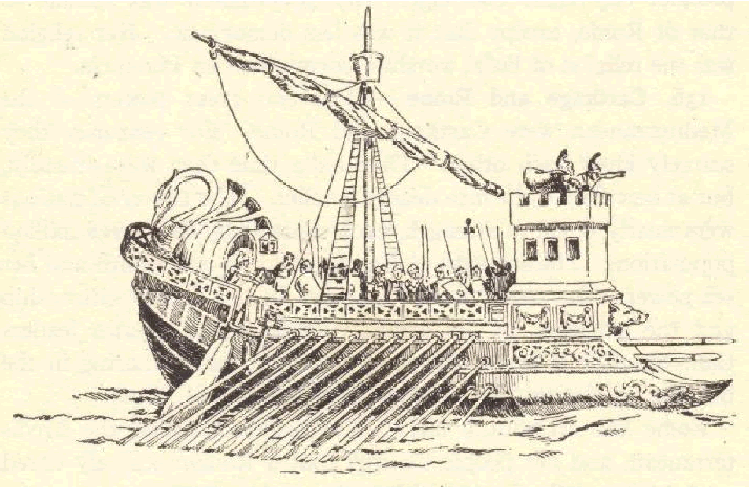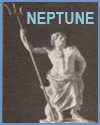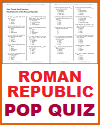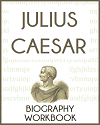| Ancient Roman Trireme |
| www.studenthandouts.com > World History > Ancient Rome > Ancient Rome Maps and Pictures |
 |
|
An Ancient Roman Trireme (Reconstruction) The trireme was planned for fighting at close quarters. The bow was strongly built, to withstand the shock when its powerful metal ram pierced the side of an enemy ship. The ram protruded from below the raised deck or castle tower, at the front, the part of a ship now known as the forecastle. Sometimes the warship had one sail, often two or more. Back of the tower was a long deck for light-armed soldiers, with places for the oarsmen below. The rowers were arranged about as in the Greek trireme. Near the stern was a deckhouse for the captain, with seats for the steersmen who guided the ship with sweeps hanging one from each side. In front of the stern post a carved ornament, the "goose-head," symbolized the floating powers of the ship. In later times, even down to the nineteenth century, vessels with several banks of oars, called galleys, were rowed by captives and prisoners known as galley slaves. Click here to enlarge this image. Ancient Roman triremes, like their Greek predecessors, were formidable warships that provided several advantages in naval warfare. These advantages contributed to their success in the Mediterranean and other waters during the height of the Roman Republic and Empire. Speed and Agility: Triremes were named after their three banks of oars, and this design allowed for impressive speed and maneuverability. The multiple oars and trireme's sleek design made it one of the fastest ships of its time, enabling it to quickly respond to changing battle conditions, pursue or escape enemies, and outmaneuver opponents in combat. Ramming Capability: Triremes were equipped with a reinforced prow, known as a rostrum or ram, often made of bronze or iron. The primary tactic in ancient naval warfare was to ram enemy ships, aiming to puncture their hulls and sink them. The trireme's speed and the force generated by its multiple rowers made it particularly effective in ramming attacks. Crew Efficiency: The trireme required a large crew, typically around 170 rowers, plus marines and officers. The coordinated efforts of the rowers allowed for rapid acceleration and effective maneuvers in battle. Crew training and discipline were key to the trireme's success. Armament: Triremes were armed with a variety of weapons, including archers and marines who could engage the enemy with ranged weapons. In addition to the ram, they may have been equipped with additional offensive weaponry like catapults or ballistae. Boarding and Infantry: Triremes often carried marines (infantry) who could be deployed for boarding actions. These marines could seize enemy ships or engage in hand-to-hand combat on the enemy vessel's deck. Versatility: Triremes were versatile ships, capable of both naval warfare and transport. They could carry troops, supplies, and equipment, making them valuable assets in amphibious operations and during campaigns that required mobility. Escort and Patrol: Triremes were used not only in major naval battles but also for escorting convoys, patrolling coastal areas, and protecting trade routes. Their presence helped deter piracy and safeguard Roman interests. Roman Organization: The Romans were known for their military organization and discipline, which extended to their naval forces. The efficient administration and command structure of the Roman navy made the most of the trireme's capabilities. Cohesion: The trireme's design promoted rowers to work in harmony and coordination. This cohesion was crucial in naval warfare, allowing the ship to respond to changing conditions and maintain formation in battle. Effective Navy: The Roman trireme, along with other warships, constituted a powerful navy. The Romans used their naval forces to secure their Mediterranean territories, protect trade routes, and project power across the seas. It is important to note that the success of triremes in Roman naval warfare was not solely due to the ships themselves but also to the skill and training of the crews, the tactics developed, and the strategic use of naval forces by the Romans. Triremes played a pivotal role in the defense and expansion of the Roman Empire, and their design and principles had a lasting impact on naval warfare. |
 |
 |
 |
 |
 |
 |
|---|
| Ancient Rome Books and Films | Ancient Rome Outlines and PowerPoints |
| Ancient Rome Maps and Pictures | Ancient Rome Study Games |
| Ancient Rome Miscellany | Ancient Rome Worksheets |
| www.studenthandouts.com > World History > Ancient Rome > Ancient Rome Maps and Pictures |






